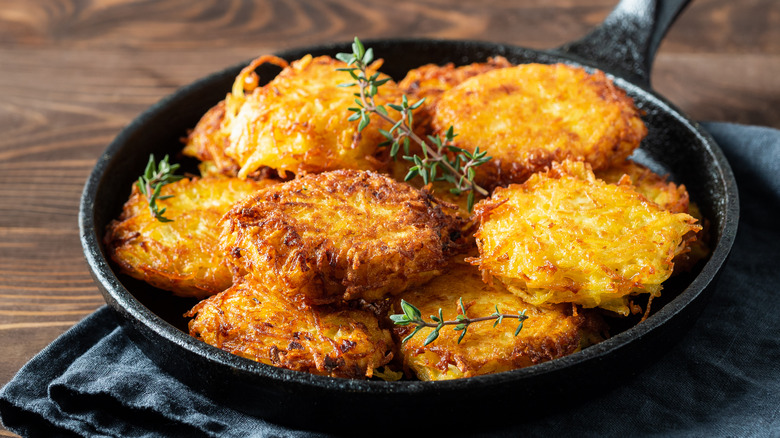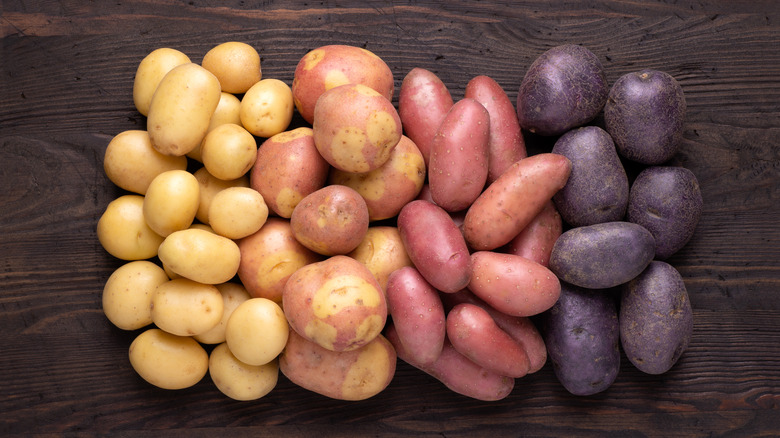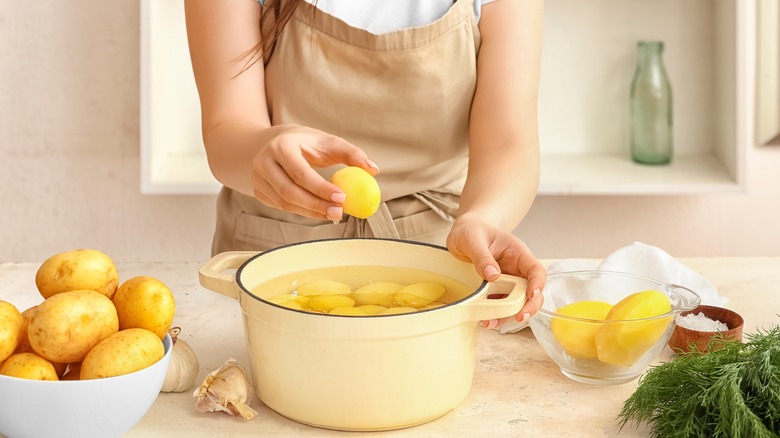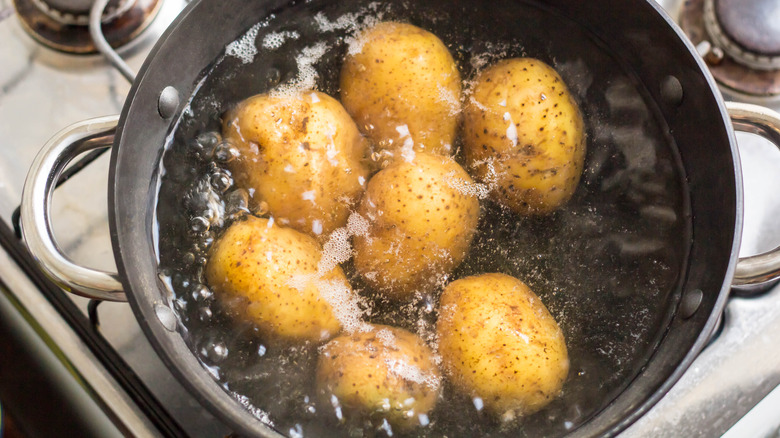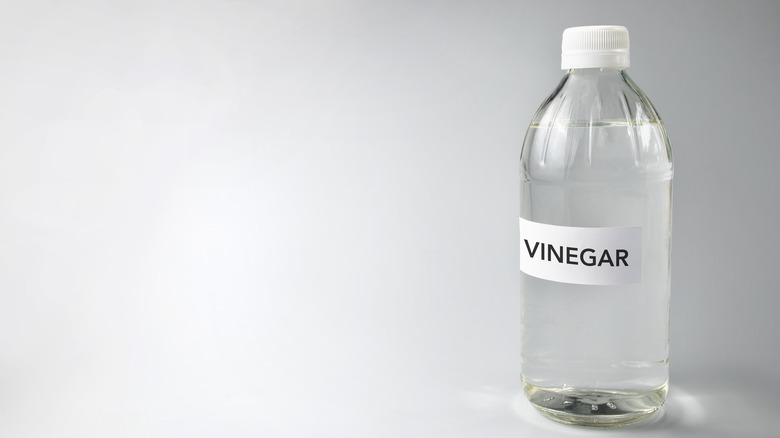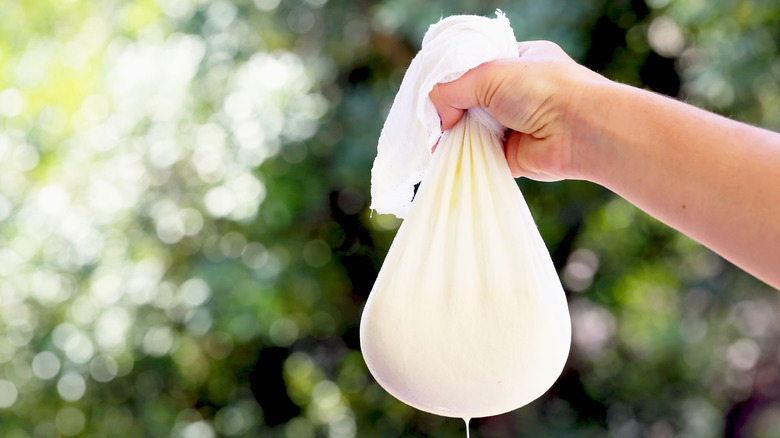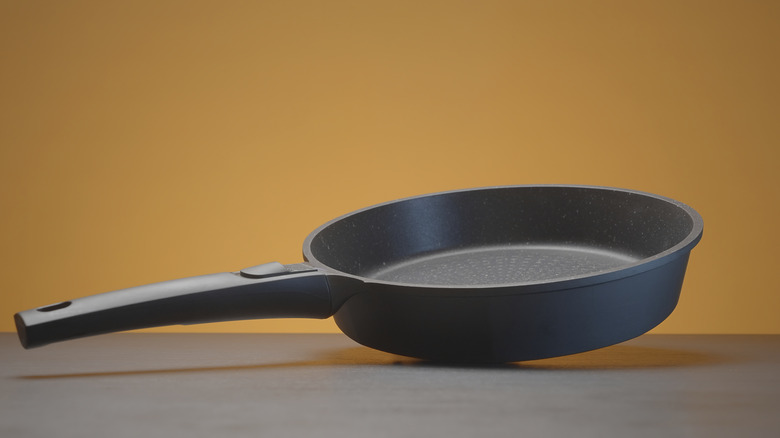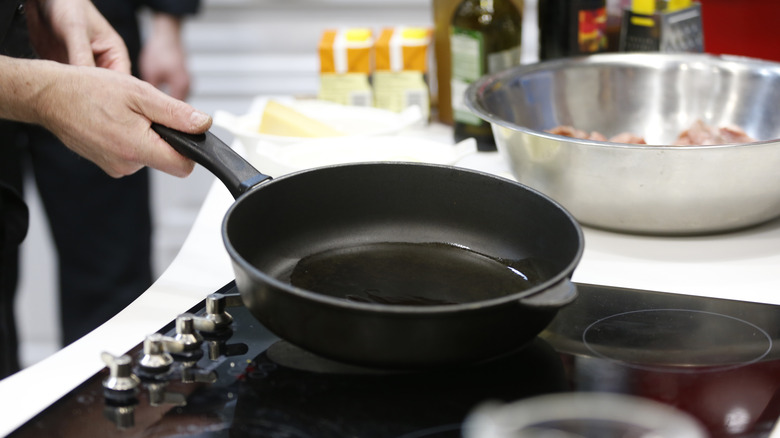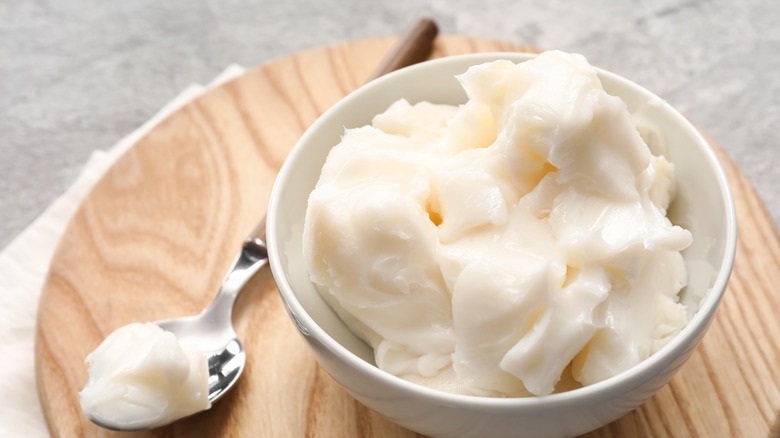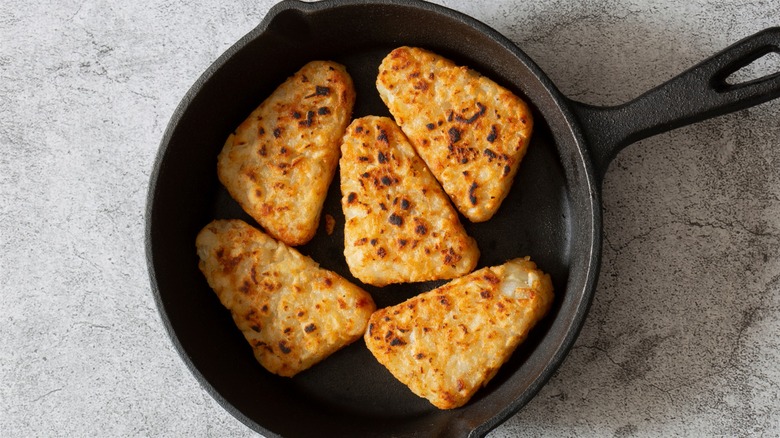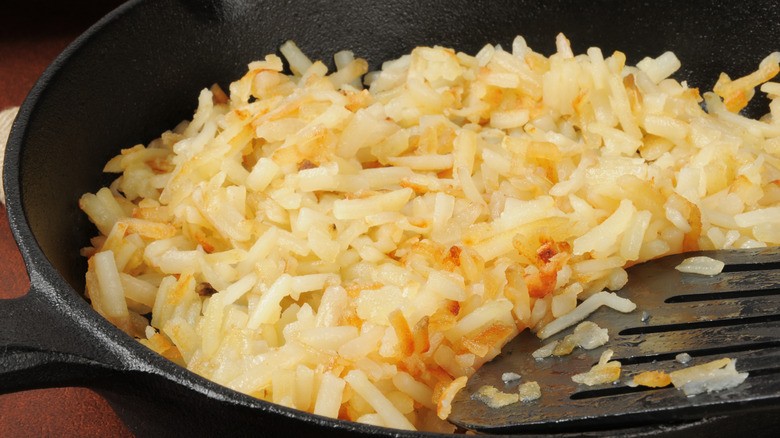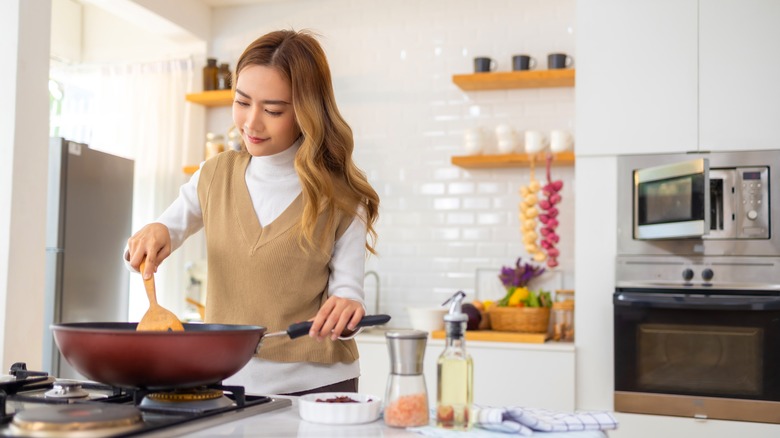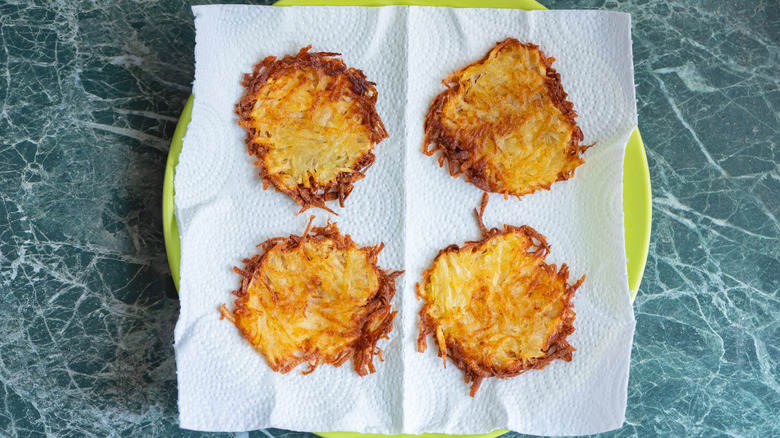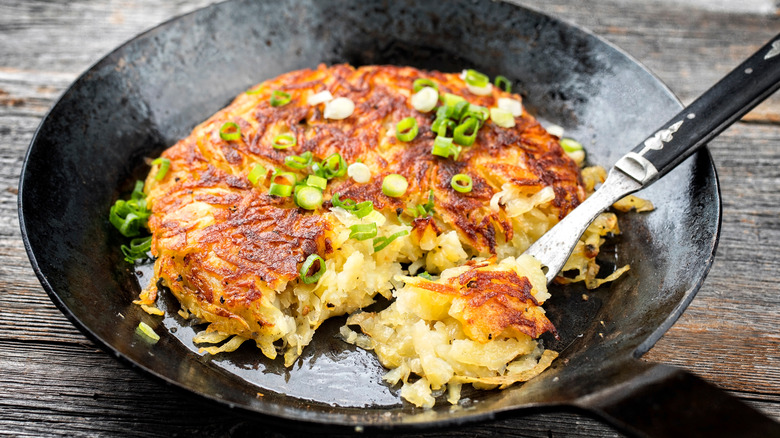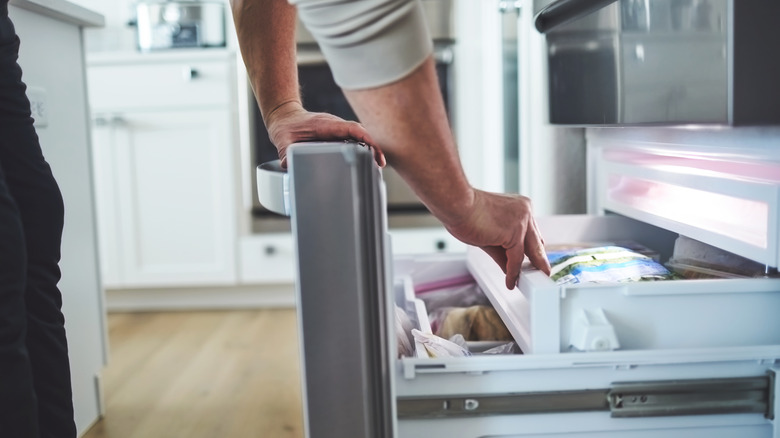Tips For Making Perfectly Crispy Hash Browns Every Time
With their buttery crust and soft interior, hash browns are the holy grail of breakfast food, a beautifully simple union of textures and flavor. But if you've ever tried to replicate mouth-watering restaurant hash browns at home, you have probably discovered the hard way that producing crispy results is a lot more challenging than it looks. The most common outcome is a rubbery, oily heap of grated potatoes that no amount of salt can salvage.
The process is simple enough: Just combine shredded potatoes, salt, and fat in a pan and cook them until they are crispy and browned on the outside and soft and pale in the middle. It's three ingredients and one pan. It should be easier than pancakes. And yet, if you poke around the internet or peruse a bookshelf of cookbooks, you are certain to find an abundance of conflicting tips, techniques, and ironclad rules that leave you feeling even less enlightened and a good deal less confident about recreating the perfect hash. Do you use cooked potatoes or raw potatoes? Should you soak them first to remove the starch or leave them as is? Should they be paper thin to maximize crispiness or thick and chunky to maximize the soft center? It's enough to make even the most self-assured home cooks hurl their aprons into the corner and head for the nearest McDonald's. But don't despair. There is a no-fail formula for producing crispy hash browns every single time, and we have all the details.
Choose the right potatoes
Hash browns are (roughly speaking) made up of about 99% potato, so it stands to reason that you should choose your potatoes wisely. We're not talking about sweet potatoes versus white potatoes. As far as we're concerned, sweet potato hash is in a category of its own and cannot be classified as hash browns. But even within the realm of white potatoes, there is significant variability, particularly in texture.
Broadly speaking, there are two categories: waxy and starchy. For hash browns, you want the starchiest potatoes you can find. Waxy potatoes have less starch and higher water content, both of which make them less inclined to get crispy. Starchy potatoes, in contrast, will give you all the crispiness you could wish for. They do not hold their shape as well as waxy potatoes, but while this makes them slightly more difficult to work with, it does provide that tender center that is so irresistible. When shopping for starchy potatoes, russet potatoes (also called Idaho potatoes) should be at the top of your list. You'll recognize them as the stereotypical baked potato, and when it comes to making hash browns, you won't find a better option.
Soak or rinse the potatoes
One of the many pitfalls of making the perfect hash browns is having either too much or too little starch. Russet potatoes are the best option because their abundant starch granules swell and burst when exposed to heat, creating that heavenly crispy layer on the outside. However, too much starch can lead to a gummy texture, making the potato strands gooey rather than fluffy.
To avoid having to choose between soggy hash browns and gooey ones, you need to soak the potatoes before cooking them. Doing so removes the excess starch without resorting to a variety of potatoes that has too little of it.
After washing, peeling, and grating the potatoes, put them in a colander and run cold water through them until it runs clear. This step only takes an extra minute or two and is the first opportunity you have to promote the potatoes' crispiness. Each step builds on the next, and starting strong with a thorough rinse will set the rest of the process up for success.
Pre-cook them
You want your hash browns to be crunchy, but not because they're raw. Uncooked potatoes are bitter and unappetizing, and bear no resemblance to the fluffy, browned hash browns you devour in restaurants. However, it's easy to end up with raw potatoes when you make hash browns at home, especially if your pan is too hot and you're worried about burning the outside, or if the hash browns are extra thick.
To mitigate the risks of raw potatoes, we recommend pre-cooking them in the microwave for a couple of minutes. This won't turn them into mash. All it does is ensure that once they hit the pan, your only concern is crisping the outside, not cooking the inside. Once you've washed the excess starch off the grated potatoes, microwave them for two minutes, keeping in mind that more time does not equal better results. If you microwave them for too long, your hash browns will turn out dry rather than crispy.
If you don't have a microwave or would prefer not to use it, you can parboil the potatoes before grating them. This takes longer –- about 15 or 20 minutes –- but it does the job, provided you don't let them get too tender.
Use vinegar
If you do choose to parboil the potatoes instead of zapping them in the microwave, one simple ingredient will vastly improve the ultimate quality of your hash browns: vinegar. It doesn't have to be fancy, either. You don't have to use apple cider vinegar or red wine vinegar. Distilled white vinegar will do the trick. The reason it works wonders is because it prevents the potatoes from falling apart as soon as you try to fry them. As potatoes cook, pectin, the gluey substance that holds them together, breaks down and leaves you with lumps of mushy potatoes rather than whole ones. By the time you try to grate them and fry them (let alone flip them), there will be no hope of neatly shaped patties, or anything close to patties at all.
Vinegar makes the pectin break down more slowly so that by the time the potatoes are sufficiently parboiled, they won't have fallen apart. One tablespoon of vinegar per quart of water is enough. If you get carried away with it you might end up with vinegar-flavored hash browns.
Drain the potatoes
Aside from a lack of starch, there is one other major liability when trying to achieve crispy hash browns: moisture. Excess liquid is a recipe for sogginess, and you should do everything you can to dry the potatoes before frying them. We know what you're thinking: Why go to the hassle of soaking and boiling the potatoes if you're just going to spend time drying them afterward? It does seem contradictory, but much of the success of crispy hash browns lies in the balance of starch, moisture, and oil. Finessing each one into just the right ratio is key.
The best way to get rid of the liquid is to put the grated potatoes in a kitchen towel or piece of cheesecloth and squeeze. You can also put them back in the colander and compress them by hand to get the water out. For a final moisture-busting measure, pat the potatoes with a dry cloth or paper towel.
Opt for a nonstick pan
Luckily, not all the steps involved in making the crispiest hash browns require more time and effort. A simple, nonstick pan is one of the best ways to ensure your creation holds together and becomes crispy. Its coating will minimize the need for excessive oil, allowing the natural sugars in the potatoes to caramelize and turn golden brown and crispy. (A cast-iron skillet is also an excellent option.)
One of the risks of not using a nonstick skillet is that the hash browns will stick to the surface, making it impossible to flip or extricate them without leaving behind the crust. Not only will this create a mess in your pan that is tough to clean, but it will also rob you of the most delicious part of the hash browns. The other danger of not using a nonstick or cast-iron skillet is that you might try to prevent the potatoes from sticking by cooking them at a low temperature. While this will probably achieve your stick-free goal, it will not produce a crispy outer layer. Instead, the oil will seep into the potatoes, making them oily and soggy.
Preheat the pan
Preheating is a game-changer when it comes to making a crispy, browned crust. If you've ever found that your first pancake is always the worst, it's probably because you started with an insufficiently hot pan. When the pan is too cool, the inside of your food will finish cooking before the outside has a chance to brown. You will either be forced to continue cooking it and accept that the inside will be overcooked, or take it off the heat and accept a pale, rubbery exterior. This is particularly noticeable when cooking steak, where a pink center and hard crust are essential.
If you're cooking vegetables, including potatoes, there is another issue to worry about. When the pan is insufficiently hot, you will be steaming them with their internal moisture rather than sautéing them. To gauge whether your pan is hot enough, flick a few drops of water onto it. They should pop, sizzle, and quickly evaporate. If they don't, wait another 30 seconds and try again. If you're using a cast-iron skillet, the preheating process will take longer, but the material will retain heat better and you'll get a thicker, darker crust and more uniform results.
Use rendered fat
There are so few ingredients in hash browns that it's worth being deliberate about each one. Plenty of recipes call for vegetable oil or butter, and while these will produce decent results, rendered animal fat will give you the kind of knock-your-socks-off flavor and crispness that you're dreaming of. Saturated fat is usually highlighted for its health risks, but there is no getting around the fact that it is the hero ingredient in hash browns. If you can get your hands on a jar of duck fat, beef tallow, or lard, you are almost guaranteed to have the best-tasting hash browns you've ever tasted.
There are several reasons why rendered animal fat has such a big impact. For one thing, it has a higher smoke point than butter, which is a boon when the hotter you can get the oil, the crispier the outside of the hash browns will be. Butter starts to burn around 350 degrees Fahrenheit, while duck fat and lard have smoke points upwards of 370 degrees Fahrenheit, and beef tallow has a smoke point of 400 degrees Fahrenheit. Many vegetable oils have higher smoke points than animal fats do, but they cannot match their flavor. Refined vegetable oils are robbed of their flavor during processing, while the delicate aroma compounds and volatile fatty acids in unrefined vegetable oils are killed off when exposed to high heat. Animal fats, in contrast, develop richer, more complex flavors when cooked because oxidation creates new flavor compounds.
Don't overcrowd the pan
Hash browns come in all shapes and sizes, but there are some rules of thumb to follow if you want them to be crispy. First and foremost, avoid crowding the pan, either by adding too many patties or by making them too thick. In order to get the distinctive crust, the potatoes have to undergo the Maillard reaction, a chemical reaction between amino acids and reducing sugars that creates everything from the crispy dark crust on seared steaks to the fragrant brown crunchiness on toast. Not only does the reaction make food crispy and browned, but it alters its flavor by breaking down and rearranging some of its chemical bonds.
For the reaction to occur, you need a high enough temperature to rapidly evaporate the moisture in the potatoes. Piling too many potatoes in the pan brings down the temperature and traps steam, making it impossible for their outsides to become crispy. Instead of frying in the fat, the hash browns will steam in their own moisture, preventing the Maillard reaction from occurring. For the best results, leave space between the hash browns so that you can see the bottom of the pan between them, and make sure they are no more than a half-inch thick to avoid excessive moisture.
Press down on the potatoes
Russet potatoes are known for their fluffiness, and while this is a big plus when it comes to hash browns (who wants dense, soggy potatoes?), the downside is that they do not hold together well. This can make it difficult to produce visually appealing patties rather than bits and pieces of them. They'll still taste delicious, but it's disappointing to make perfectly seasoned, crispy hash browns and not have their appearance do them justice.
The best way to make them hold their shape, apart from the controversial option to add eggs, is to press them gently with your spatula. This encourages the grated pieces to stick together and ensures even more contact with the hot pan for consistent browning. You'll hear a satisfying sizzle as you do this, which indicates that you're on your way to achieving even, crispy crust and patties that are compact enough not to fall apart at the slightest nudge.
Take your time
Cooking hash browns is not a lengthy process compared to, for example, baking a cake, but you can't rush it or you'll end up with undercooked, floppy results. Even worse, if you try to speed it up by overheating the pan, you'll end up with charcoal. "Patience" and "hash browns" are not a happy pairing, but if you want the latter to be the best that they can be, you have to summon a bit of the former.
The proper temperature for your pan is medium-high. If it doesn't feel hot enough, you probably need to let it preheat longer rather than turn up the temperature. Steady heat will ensure that the hash browns cook evenly on each side. Try not to move the patties around while you wait for them to cook. Just press them with your spatula and wait at least 60 seconds before gently lifting an edge to see it's browning. Once it's reached the color and texture of your choosing, gently flip it, and leave the other side to cook undisturbed. Try not to flip them too soon, as they need to sizzle to form that protective crunchy layer that keeps out excess oil. If you flip them too early or cook them more than once on each side, you may end up with oil-logged potatoes.
Drain them on paper towels or a drying rack
One of the biggest mistakes you can make with hash browns is not draining the grease once they've been cooked. It's easy to forget this step when you've just produced the crispiest, fluffiest hash you've ever seen and want to dig right in, but those crunchy edges are likely to turn soggy with grease if you don't put them on paper towels first.
Draining the oil is almost as important as the cooking itself when it comes to ensuring the desired texture, and if you're used to deep-frying foods, you'll know that it's a non-negotiable part of the process. While you're waiting for the hash browns to cook, put several layers of paper towels on your counter. Once the hash browns have finished cooking, transfer them immediately to the paper towels for a minute or two, and make sure to flip them to remove grease on both sides. If the pan has a layer of oil on the bottom, you might want to drain the hash browns on cooling racks instead, as paper towels may be insufficient.
Serve them immediately
The window of time when your hash browns are crispy is frustratingly brief. Despite being dried before cooking, the potatoes will still have moisture in them, and even after you remove them from the heat, they will continue to steam. If you seal them in a container with the intention of serving them later, that steam will get trapped and sink straight back into the potatoes like water into a sponge.
The best solution is to serve them immediately after putting them on paper towels to get rid of the extra grease, but this can be an issue if you're cooking multiple batches and want to serve them all at the same time. In this case, you can transfer the hot hash browns to your oven. Set the temperature at 200 degrees Fahrenheit to keep the steam rising rather than condensing back into liquid. The steam will also keep the oil from seeping into the crust and turning it soggy with grease.
If you need to make them ahead, freeze them uncooked
Given how tricky it is to avoid soggy hash browns, you might assume that freezing them is out of the question. However, it is possible to have the best of both worlds — crispy homemade hash browns right out of the freezer.
The key is to freeze them halfway through the process, just before cooking them. After peeling, grating, and par-cooking them, whether in the microwave or on the stove, form them into the shape you want and arrange them in a single layer on nonstick parchment paper or a silicone mat. Make sure to stow them in an airtight container to avoid freezer burn, which occurs when the moisture in your food evaporates into the dry air of the freezer. This leaves discoloration and a damaged texture, both of which can ruin a perfectly good batch of hash browns. When you're ready to cook them, all you have to do is heat a pan, add fat, and toss them in. You can thaw them if you're worried about the inside staying frozen, but if you make them thin enough (¼ to ½ inch thick), they will easily cook all the way through.
